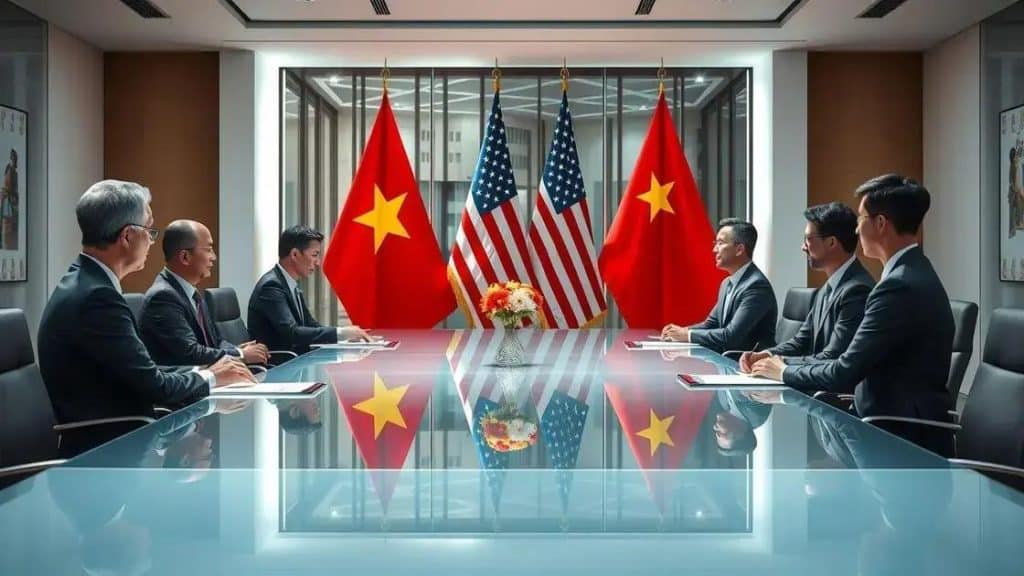U.S.–Vietnam trade agreement updates: what you need to know

The U.S.–Vietnam trade agreement enhances market access, reduces tariffs, and supports economic growth, benefiting both U.S. businesses and the Vietnamese economy while fostering collaboration and innovation.
U.S.–Vietnam trade agreement updates are reshaping the economic landscape, influencing various sectors. Curious about how these changes might affect you? Let’s dive into the current developments and what they mean for both nations.
Current status of the trade agreement
The current status of the trade agreement between the U.S. and Vietnam is crucial for understanding future economic interactions. Over the past few years, both countries have made significant strides in refining their trade policies, aiming to boost cooperation and mutual benefits.
As of now, the agreement facilitates trade in various sectors such as agriculture, technology, and manufacturing. It has allowed Vietnamese goods to enter the U.S. market more easily, while American businesses gain better access to one of Southeast Asia’s fastest-growing economies.
Points of Current Focus
Key areas receiving attention include:
- Tariff reductions on imports and exports
- Labor laws and working conditions
- Environmental regulations
- Intellectual property protections
These discussions are vital as they set the framework for long-term collaboration. Both nations are examining ways to enhance trade efficiency while addressing concerns about fair practices and sustainability.
Furthermore, regular meetings between leaders from both countries help to clarify goals and resolve ongoing issues. It’s essential for businesses and consumers to stay informed about developments, as these updates can impact pricing and availability of products.
Overall, the U.S.–Vietnam trade agreement is evolving and requires ongoing attention from stakeholders, helping ensure a fair trading environment.
Impact on U.S. businesses

The impact on U.S. businesses due to the trade agreement with Vietnam is significant and multifaceted. Many American companies are already experiencing changes in their operations and strategies because of enhanced trade relations.
One of the primary benefits is greater access to a booming market. American firms can now export goods to Vietnam with reduced tariffs, which encourages more competitive pricing. Products ranging from agricultural goods to technology have seen increased demand. This access enables U.S. businesses to expand their customer base overseas, boosting sales and revenue.
Key Benefits for U.S. Businesses
Some major benefits include:
- Increased market presence in Southeast Asia
- Opportunities for joint ventures and partnerships
- Expansion in technology transfers and innovation
- Better sourcing options for raw materials
Moreover, U.S. companies are benefiting from the exchange of ideas and best practices. This collaboration can lead to significant advancements in production efficiency and product quality. As businesses work closely with Vietnamese counterparts, they often discover new technologies and methods that enhance their operations.
However, the agreement also presents challenges for some sectors. There may be increased competition from Vietnamese products in the U.S. market. Consequently, companies must adapt to remain competitive, possibly requiring adjustments in pricing and marketing strategies.
Overall, the impact on U.S. businesses is largely positive, offering vast potential. To leverage these advantages, companies must stay engaged and informed about the evolving trade landscape.
Effects on Vietnamese economy
The effects on the Vietnamese economy from the trade agreement with the U.S. are profound and varied. This agreement has opened many doors for Vietnamese businesses, enhancing their ability to compete in the global market.
With the reduction of tariffs, Vietnamese products can now reach U.S. consumers more easily. This access has led to a surge in exports, benefiting sectors such as textiles, electronics, and agriculture. Vietnamese farmers, for example, are experiencing increased demand for rice and coffee, significantly boosting their income.
Key Economic Impacts
Some critical impacts include:
- Growth in manufacturing jobs
- Increased foreign direct investment
- Rising wages for workers
- Enhanced infrastructure development
As jobs multiply, the standard of living for many Vietnamese people is improving. Moreover, foreign investors are eager to tap into Vietnam’s growing market, leading to an influx of capital that furthers development. This economic growth fosters a sense of optimism among Vietnamese entrepreneurs, who are now exploring new ventures and innovative ideas.
However, there are challenges to consider. The rapid growth can lead to increased competition within certain industries. Smaller Vietnamese businesses may struggle to keep pace with larger foreign companies. It’s essential for these businesses to adapt and innovate to survive. The government is also focused on providing support to these enterprises, ensuring they are equipped to thrive in the evolving economic landscape.
Overall, the trade agreement has a substantial positive influence on the Vietnamese economy. As the country continues to embrace these changes, the focus remains on building a sustainable and inclusive growth model that benefits all Vietnamese people.
Future projections and expectations

The future projections and expectations for the U.S.–Vietnam trade agreement are optimistic, with both countries eager to strengthen their economic ties. Experts predict that continued collaboration will lead to mutual benefits for years to come.
One significant expectation is further tariff reductions. As both nations work together, more products may see lower tariffs, enhancing trade volumes even more. This could create a ripple effect, encouraging more businesses to export and import goods.
Anticipated Developments
Some anticipated developments include:
- Expansion of trade into new sectors
- Increased focus on sustainability and environmental practices
- Enhancements in labor standards
- Strengthened intellectual property protections
The agreement is expected to evolve, allowing for adjustments based on changes in the global market. For example, as demand for technology rises, both nations may find ways to capitalize on this trend. Cooperation in research and development could further enhance technological innovation.
Moreover, the emergence of new challenges, such as global supply chain disruptions or geopolitical tensions, might also influence future negotiations. Both the U.S. and Vietnam are aware of these factors and are expected to remain agile in their approaches.
As the trade relationship matures, stakeholders from both nations will likely engage in frequent dialogue to ensure the agreement meets evolving needs. By focusing on adaptability and collaboration, the U.S.–Vietnam trade agreement can continue to foster economic growth and resilience.
FAQ – Frequently Asked Questions about the U.S.–Vietnam Trade Agreement
What are the primary benefits of the U.S.–Vietnam trade agreement?
The agreement provides greater market access, reduces tariffs, and increases opportunities for both U.S. and Vietnamese businesses.
How does the agreement impact U.S. consumers?
U.S. consumers may benefit from lower prices and a wider variety of Vietnamese goods in the market due to reduced tariffs.
What challenges might arise from the trade agreement?
Increased competition could challenge smaller businesses, requiring them to adapt to stay competitive in the evolving market.
How can businesses prepare for future developments in trade relations?
Businesses should stay informed about changes in trade policies, explore new markets, and consider partnerships to strengthen their operations.





